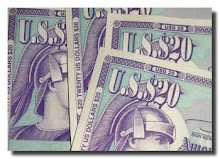Why investors are optimistic, and what they ought to worry about
INVESTORS have entered this year in a buoyant mood. After global equities returned 18% in 2006, many stockmarkets have started 2007 either at record highs or close to them.
Two factors have fuelled investors' optimism. The first is the slightly vague notion of liquidity (see article). There is no universally agreed definition of this concept; best to say you know it when you see it. What is clear is that there is a lot of it about. Investors have felt sufficiently flush with cash to buy high-risk assets, such as junk bonds or commodity futures. Credit has been plentiful for those who need to borrow.
The second factor is corporate profits, which have risen faster and for longer than anyone expected a few years ago. Companies have used their cash to buy back shares, supporting the stockmarket, and the high level of profitability has reduced defaults, helping bonds.
The bullish trends are clearest in the private-equity industry, which has some $300 billion of cash ready to spend, according to Morgan Stanley. Liquidity explains why this business has so much cash; and companies' fat profits (along with low interest rates) explain why private-equity houses are so keen to buy them.
So is the world experiencing another bubble, akin to the one that popped so spectacularly in 2000? Not yet. The four-year-old bull market has been unusual, in that share prices have been pushed higher by rising profits rather than higher ratings. As a result, many analysts think shares are still undervalued, especially relative to government bonds. Nor has the bull market been accompanied by any mania among retail investors, such as the “day trading” fad of the late 1990s.
It is thus not difficult to imagine that financial markets can stay buoyant for a while yet. Investors will be reluctant to sell shares if they believe takeover bids are imminent, especially when the returns on government and corporate bonds are so low by historical standards.
Bulls will also take heart from the ease with which markets have shrugged off so many worries in recent years—high oil prices, the American current-account deficit, terrorism. Those who sold in haste have repented at leisure. Figures over Christmas, showing that home sales were picking up, have helped investors put aside the most recent cause for concern, that the American economy might be hit by a collapse in the housing market. January's rebound in a widely watched survey of manufacturers will have the same effect. And even if the economy falters, investors believe they have a “get out of jail free” card in the Federal Reserve which, having raised rates all the way from 1% to 5.25%, now has scope for a cut.
Reasons to be careful: one, two, three
However, the moment when investors are most complacent is also the moment of greatest danger. Merrill Lynch's survey of global fund managers, conducted in December, showed that investors were expecting slightly slower growth in GDP and profits this year, but were not worried about either recessionor inflation. Most therefore had an above-average weighting of shares in their portfolios. Meanwhile, a poll of Wall Street strategists found that not a single pundit was predicting that American shares would fall this year. And measures of volatility (for shares, bonds or currencies) have been strikingly low.
This sangfroid could be tested by several threats. First, the share of corporate profits in American GDP is already at its highest since 1950. Analysts are blithely assuming they can keep rising. Perhaps globalisation has shifted the balance of power firmly in favour of the corporate sector and away from labour. But workers have votes and may demand the balance be shifted back, either through taxes or trade barriers.
Second, the American economy may not follow the benign path that the consensus assumes. The housingmarket's downswing may not yet be over; and its weakness could prompt consumers to increase their ultra-low saving rates, cutting into demand. Alternatively, growth and inflation may well turn out to be strong enough to persuade the Fed to leave rates unchanged.
Finally, there are the credit markets. The creation of new instruments, such as complicated derivatives, probably makes the financial system stronger in the long run, by ensuring risk is better priced and more widely distributed. But some of these instruments have yet to be tested by a severe recession or a big corporate default. If most people have made the same bet (that risky assets will outperform and that volatility will stay low), there could be an almighty scramble for the exits when the trend changes.
Bull markets are remarkably resilient. But it would be surprising if one of those threats did not cause confidence to wobble at some stage in 2007.
Global markets Bull session
Sunday, March 2, 2008 At: 3/02/2008 01:00:00 AM by Joyce.gardner
Foreign
Exchange Calculator
|
||||||||
|
| Conversion : What do you want to convert to? |
Rates as of Fri Feb 29 18:05:03 EST 2008
Note: Rates may change throughout the day and may differ at the time
of booking. These rates apply to foreign exchange transactions with the
exception of the purchase and sale of currency notes (cash).

